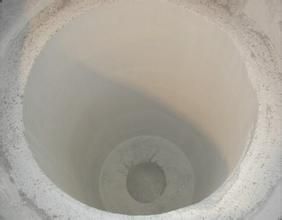What are the special advantages of using coil insulating glue?
Today, Luoyang Quantong Kiln Industry Co., Ltd. will take you to understand what are the special advantages of using coil insulation cement?
1. After drying, the coil insulating mastic layer with a thickness of 8-15mm has good insulating properties, and can completely replace mica and glass wool cloth as an insulating protective layer between the coil and the furnace lining; the thermal conductivity of the mastic material is high, and it is not necessary to Worried that a relatively thick layer of cement will affect the 3-layer junction of the hot-face lining;
2. The cement layer is located between the coil and the insulation layer. Under normal circumstances, the ambient temperature is very low (<300 degrees="" celsius.="" occasionally,="" when="" the="" metal="" liquid="" approaches="" its="" surface,="" the="" cement="" layer="" will="" release="" a="" small="" amount="" of="" residual="" moisture,="" which="" reduces="" the="" insulation="" resistance.="" the="" system="" provides="" early="">
3. Using the refractoriness of the cement itself higher than 1800 degrees Celsius, when the metal liquid leaks to its surface occasionally, the cement can provide a protective barrier for the coil, and when an alarm occurs, the cement layer can provide a certain amount of accident handling time;
4. For the furnace with bottom top-out type, the cement is made into a tapered shape to avoid the friction between the furnace lining and the coil, and at the same time, the coil is fixed by its strength, which avoids the use, construction and dismantling of the coil. The deformation during the furnace process prolongs the service life of the coil.
5. The coil and the cement layer are used as the permanent fire lining of the furnace. Although the one-time cost is high and the construction period is long, its service life can be the same as that of the coil, and local repairs can also be carried out, so the overall cost of furnace construction is reduced.
Before dry knotting the furnace lining, first lay a layer of asbestos board and a layer of glass fiber cloth in the insulation layer of the furnace coil. When laying, in addition to manually flattening and compacting the materials of each layer, spring coils should be used to tighten up and down, and the quartz sand should be tamped. When the furnace lining is finished, move the spring coils one by one from top to bottom until the lining is knotted.

Previous: Furnace lining manufacturers tell you the operation steps of the oven
下一条: How to correctly construct the ramming material in the intermediate frequency furnace
Related Industry Knowledge
- Features and Benefits of Coil Clay
- What are the advantages of a good furnace lining
- Misunderstandings in the use of ramming materials in intermediate frequency furnaces
- Phenomenon analysis of failure of argon blowing of ladle permeable bricks and how to improve the rate of argon blowing
- Where is the consumption reduction and energy saving of breathable bricks reflected?
- How to improve the service life of intermediate frequency furnace lining
- Reasons for damage to intermediate frequency furnace lining and how to solve them
- The performance and advantages of breathable brick
- Analysis of Structural Characteristics of Dispersive Breathable Bricks
- The intermediate frequency furnace charge knotting process needs to pay attention to details sharing
- Furnace lining manufacturers tell you the operation steps of the oven
- Analysis of Corrosion Phenomenon of Furnace Surface Lining
- Why does the intermediate frequency furnace lining have cracks?
- Cause Analysis of Damaged Refractory Material of Submerged Arc Furnace Lining
- Will the ramming material attack chemically?
- Do you know how to choose the correct acid furnace lining
- How to repair the electric furnace lining
- What should be paid attention to when lining the furnace
- Introduction of ramming material for intermediate frequency furnace
- Influence of medium frequency electric furnace lining material


